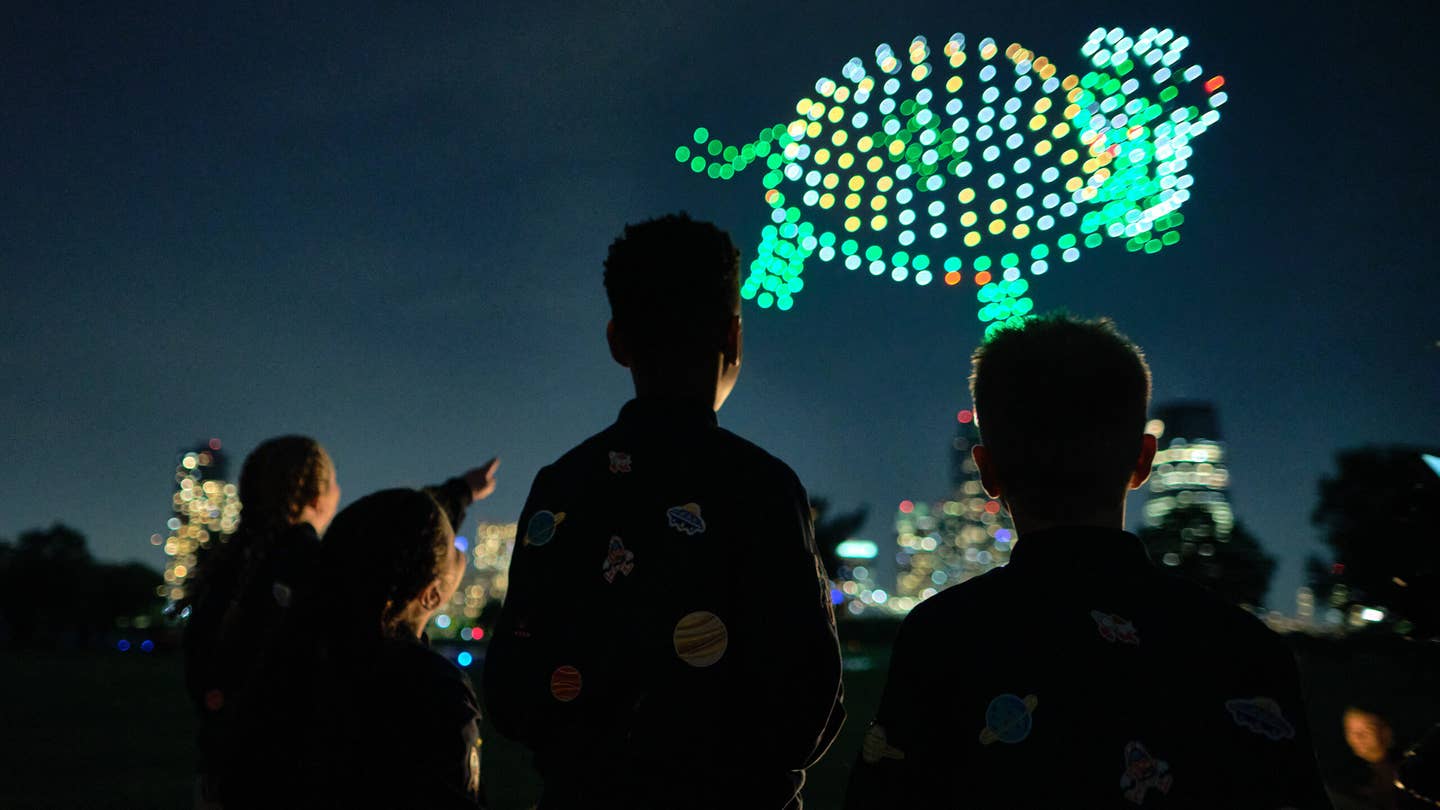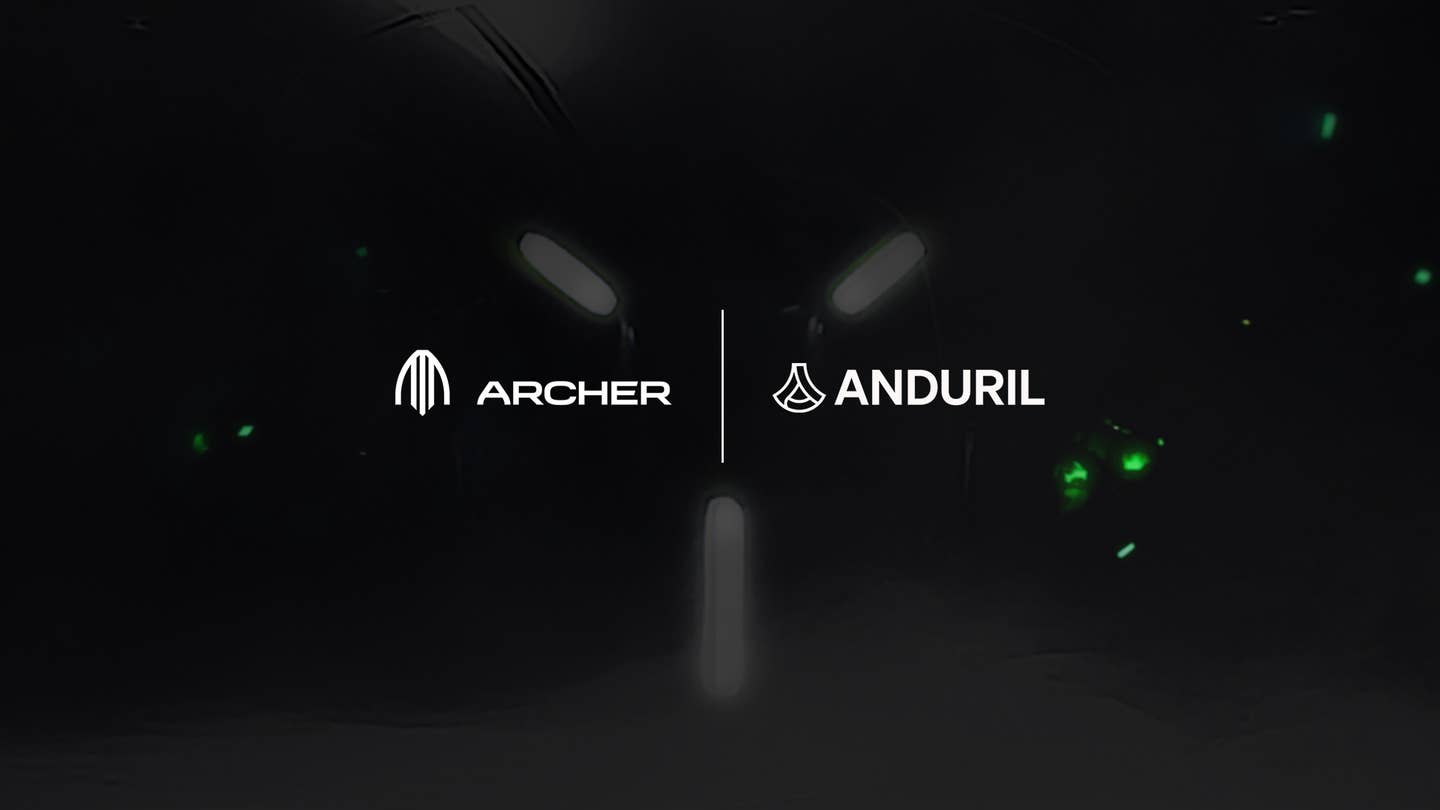Earthlings, We Come in Pieces: Legos Inspire the Next Generation of Space Explorers
Research conducted on behalf of the Lego Group finds that more than half of Generation Alpha respondents want to be astronauts when they grow up.

Young spaceship designers watch their Lego creations take flight in the form of drone constellations during an event Wednesday night in Jersey City, New Jersey. [Courtesy: Lego Group]
JERSEY CITY, New Jersey—A bed with wings, a dinosaur with a jetpack, and other whimsical creations dazzled the New York City skyline Wednesday night during an event meant to inspire the next generation of astronauts, scientists, and space explorers.
The Lego Group this week hosted a drone show under the stars, recreating imaginative spaceship designs submitted by children around the world—which the company has playfully dubbed Unidentified Playing Objects (UPOs)—using hundreds of small, buzzing aircraft.
Kids around the world were invited to submit UPO designs, with the winners seeing their spacecraft come to life (in Lego form, of course) at the Lego House in Denmark, where they will remain on display until June 17. The creations were also showcased Wednesday in Jersey City alongside Lego reconstructions of famous rockets, such as NASA’s Space Launch System.
“The imagination shown by young children around the world was mind-blowing, and this was one of the best experiences I have had,” said Didac Perez Soriano, associate master builder at the Lego House. “With so much of the universe still to be explored, we can’t say that what they have created isn’t possible—or even out there already.”
According to a recent study conducted on behalf of Lego by research firm Ipsos, 58 percent of kids surveyed said they want a career in space—more than their parents did when they were younger (49 percent) and more than any generation previously studied. In 2019, the company found that more children dreamed of being YouTubers than astronauts.
Kellie Gerardi—mission operations lead at software firm Palantir and a payload specialist and astronaut for Virgin Galactic, as well as a researcher, author, social media personality, mother, and Lego ambassador—saids meeting kids where they are, such as through play, is one of the best ways to inspire even more youngsters to pursue careers in space.
“I think [the research] goes to show that there is an innate fascination with the cosmos that exists. The tricky part is always bridging that gap,” Gerardi told FLYING. “Of course, space is incredibly exciting and interesting—who wouldn't be amazed by it? But then how do you actually metabolize that excitement and turn imagination into motivation later in life?”
Gerardi has conducted microgravity research on behalf of the International Institute for Aeronautical Sciences (IIAS) for a decade, performing parabolic flights in reduced-gravity aircraft, known colloquially as vomit comets.
One of the institute’s goals is to send researchers into space—an honor Gerardi received when she flew on Virgin Galactic’s Galactic 05 dedicated science mission in November, with Lego figures of herself and 6-year-old daughter Delta. She is one of the first payload specialists to fly to space and one of the first 100 women to reach the cosmos.
“To me, that was the dream,” Gerardi said. “I built a career in the commercial space industry. I worked at the Commercial Spaceflight Federation, starting my career in space policy—how we allow and enable these companies to do commercial human spaceflight.”
Earthlings, We Come in Pieces
Six UPOs took to the skies Wednesday night in the form of drone constellations, illuminating the New York City skyline. Among them were a Shiba Inu-shaped spaceship with 360-degree windows, a turtle spaceship complete with a slide and ladder, and plenty more.
Lotty Ingle, a 10-year-old girl from the U.K. who dreams of collecting moon rocks and visiting unexplored planets, created a double bed design that flies on butterfly wings (for both aesthetic and eco-friendly purposes). Beneath the bed is a snack drawer to feed herself—and any aliens she encounters, of course.
“I would love to travel to all the planets that no one has discovered yet and see if there is life there and if they are just like us,” said Ingle. “I would really like them to try all my favorite snacks that I am bringing with me.”
Jordan Hardnett, a 12-year-old boy from Philadelphia who hopes to one day spacewalk across the galaxy in search of aliens, designed a time-traveling spaceship with night vision goggles to help astronauts see creatures on other planets.
“I would love to travel to space,” said Hardnett. “If I could fly, I would hope to find a different species, aliens, and any type of rock to research.”
Seven-year-old Jillian Granelli, also from the U.S., wants to one day live on another planet and build a home on the moon. Her UPO, a jetpack-wearing dinosaur, is built to fly her all around the Milky Way.
“If I could travel to space, I would say hi to aliens and become friends with them,” Granelli said. “Especially the Lego aliens.”
Sebastian Mikkelsen, a 10-year-old boy who came all the way from Denmark to watch his UPO take flight, hopes to become the next Danish astronaut and visit Jupiter and Mars. His creation, a straw hat spaceship with reindeer antlers for wings, comes equipped with a high-tech computer lab and a gaming room.
“I would bring things like stones, gases, and minerals (from the planets) back home to Earth to show my classmates,” said Mikkelsen. “Maybe we can use them to develop new things that can help us on Earth. It could be new forms of energy and better electricity.”
The junior UPO designers are far from the only kids with an interest in space.
According to the study commissioned by Lego, which surveyed 16,000 children in Generation Alpha, more than three-quarters of kids aged 4 to 14 say they want to travel to the final frontier. Fifty-eight percent of them say they would like to work in space, with more than half wanting to become astronauts when they grow up.
Another 86 percent of children are interested in discovering new stars, planets, and galaxies. Nearly 7 in 10 (68 percent) believe there are aliens out there waiting to be found.
The kids’ responses were more than backed up by their parents, among whom 61 percent say their child wants to fly to space. Two-thirds of them say their child has an interest in space, and more than three-quarters think Generation Alpha children have the greatest opportunity to explore space.
Sixty-two percent of parents genuinely believe their child will one day be able to reach the final frontier. They voted Generation Alpha as more likely than any other generation to make the biggest contribution to the world’s scientific knowledge of space.
Capturing the Imagination
In addition to her work with Palantir, Virgin Galactic, and IIAS, Gerardi is also the author of the children’s book series Luna Muna, which follows the adventures of a young girl curious about the cosmos. The book was read aloud on the International Space Station (ISS) last year by the crew of Axiom Space’s Axiom-2 mission.
Gerardi said that young people naturally have plenty of interest in outer space. But there is a gap in the market for materials that capture that interest, such as books.
“We have to intentionally make those connections to allow kids to benefit from that innate curiosity and help them build on it,” Gerardi said. “So that, very similarly I think, was my motivation for creating a children's book series that centers space, meets kids where they're at with their imagination, and encourages them to see themselves represented in that way.”
Gerardi is excited about initiatives that target undergraduate students and connect them with internships at commercial space companies, government agencies, and academic institutions. IIAS, for example, offers undergraduate and postgraduate courses on astronautics, flight test engineering, and spacesuit evaluation at partner universities such as the Florida Institute of Technology and the University of Alaska Fairbanks.
The ISS National Laboratory offers internships and fellowships with companies such as Axiom Space, Blue Origin, and SpaceX, and government partners, including NASA and the Department of Defense. These organizations and others aim to send more non-NASA researchers and science experiments to space, opening the cosmos to a wider range of actors.
“It was hands down the absolute best experience of my life, and I still have intense emotional saturation six months later thinking about it,” Gerardi said of her journey to space on Galactic 05. “We had a mandatory medical debrief immediately after the flight. And the only thing I reported was cheek soreness because I was grinning through boost the entire time.”
Gerardi hopes to recreate that experience for as many people as possible. And inspiring children to explore careers in space using Legos or books is how it begins.
“The goal was always so much bigger than flying myself. It was helping blow open the door to commercial human spaceflight,” she said. “And so watching the next generation, thinking about what they'll grow up experiencing—this access to space, where the next generation of researchers can really use space as a laboratory to benefit humanity—is just very fulfilling to think about.”
Gerardi believes being an astronaut is just the tip of the iceberg when it comes to career paths in the space ecosystem for the next generation. But unless children see and understand those other jobs, it can be difficult for them to imagine they exist.
“I view space as our shared past and our shared future,” Gerardi said. “And I think that our next giant leap is going to require the talents of artists, engineers, and everyone in between…I think really we’re standing on the doorstep to a new, golden age of spaceflight.”
Like this story? We think you'll also like the Future of FLYING newsletter sent every Thursday afternoon. Sign up now.

Sign-up for newsletters & special offers!
Get the latest FLYING stories & special offers delivered directly to your inbox






